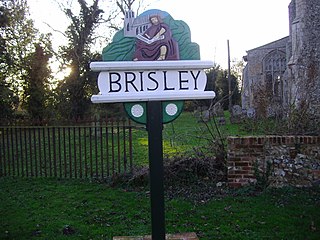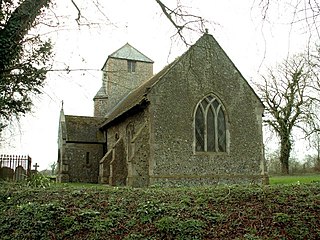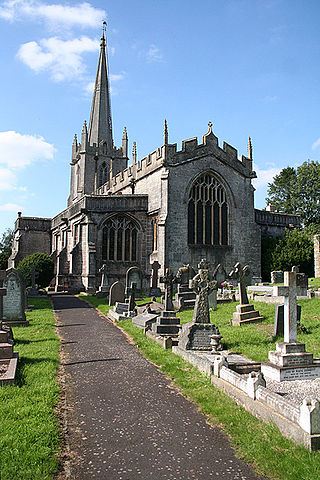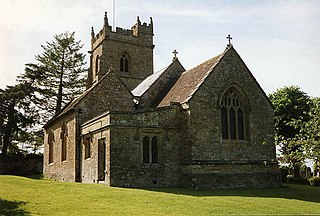
Gloucester Cathedral, formally the Cathedral Church of St Peter and the Holy and Indivisible Trinity and formerly St Peter's Abbey, in Gloucester, England, stands in the north of the city near the River Severn. It originated with the establishment of a minster, Gloucester Abbey, dedicated to Saint Peter and founded by Osric, King of the Hwicce, in around 679.

Nether Stowey is a large village in Somerset, South West England. It sits in the foothills of the Quantock Hills, just below Over Stowey. The parish of Nether Stowey covers approximately 4 km2, with a population of 1,482.

Worminghall is a village and civil parish in the Buckinghamshire district of the ceremonial county of Buckinghamshire, England.

Brisley is a village and civil parish in the English county of Norfolk.

Bunwell is a village and civil parish in the English county of Norfolk.

Blo' Norton is a village and civil parish in the Breckland district of the English county of Norfolk.

Athelington is a small village and civil parish in the Mid Suffolk district of Suffolk, England, about 12 miles (19 km) south-east from Diss. The name is derived from the Old English word Ætheling. The population of the village was less than 50 at the 2011 Census and is included in the civil parish of Redlingfield, in 2005 the population was estimated as 30.

Temple Church, also known as Holy Cross Church, is a ruined church in Redcliffe, Bristol, England. It is on the site of a previous, round church of the Knights Templar, which they built on land granted to them in the second quarter of the 12th century by Robert of Gloucester. In 1313 the Knights Hospitaller acquired the church, following the suppression of the Templars. By the early 14th century, the church served as the parish church for the area known as Temple Fee. From around the same time, the rebuilding of the church on a rectangular plan started. This was completed by 1460, with the construction of a leaning west tower. The Hospitallers would lose ownership of the church in 1540 during the Dissolution of the Monasteries.

St Helen Witton Church, Northwich, is in the centre of the town of Northwich, Cheshire, England. It is recorded in the National Heritage List for England as a designated Grade I listed building. The church is now known as "St Helen's, Witton" or "Northwich Parish Church". It is an active Anglican parish church in the diocese of Chester, the archdeaconry of Chester and the deanery of Middlewich. Alec Clifton-Taylor includes it in his list of 'best' English parish churches.

The Church of St Mary the Virgin is in Leek Road, Bosley, Cheshire, England. It is recorded in the National Heritage List for England as a designated Grade II* listed building. It is an active Anglican parish church in the diocese of Chester, the archdeaconry of Macclesfield, and the deanery of Macclesfield. Its benefice is combined with those of St Michael, North Rode, St Michael, Wincle, and St Saviour, Wildboarclough.

Tadlow is a small village and civil parish in South Cambridgeshire, England on the River Cam. It is 20 kilometres (12 mi) south-west of Cambridge and 9 kilometres (6 mi) north-east of Biggleswade, Bedfordshire. In 2001 the population was 181 and the area of the village is 681 hectares.

Brettenham is a village and civil parish in the English county of Norfolk.

The Church of St Andrew & St Mary in Pitminster, Somerset, England was built around 1300 and has been designated as a Grade I listed building.

The Anglican Church of St Mary the Virgin in Croscombe, Somerset, England, is primarily from the 15th and 16th centuries with 19th-century restoration. It has been designated as a Grade I listed building.

The Church of St Mary in Litton, Somerset, England, dates from the 13th century. It is a Grade I listed building.

The Church of St Matthew in Wookey, Somerset, England, dates from the twelfth century and is a Grade I listed building.

The Church of St Andrew in Whitestaunton, Somerset, England, dates from the 13th century and has been designated as a Grade I listed building.

The Parish Church of St Mary the Virgin is a Church of England parish church in Leigh, Greater Manchester, England. It is a member of the Salford & Leigh deanery in the archdeaconry of Salford, diocese of Manchester. It is recorded in the National Heritage List for England as a designated Grade II* listed building.

St Bartholomew's Church is a Grade I listed Anglican church dedicated to St Bartholomew the Apostle, in the English village of Welby, Lincolnshire. It is 4 miles (6 km) north-east of Grantham, and 1 mile (1.6 km) east of High Dyke, on part of the old Ermine Street Roman road. The church is in the ecclesiastical parish and Group of Ancaster and Wilsford, in the Deanery of Loveden, and the Diocese of Lincoln.

The Church of St Thomas à Becket is the Anglican parish church for the ancient village of South Cadbury in Somerset and is dedicated to Thomas Becket. Today it is one of the 'Camelot Churches' of South Somerset in the Diocese of Bath and Wells and has been a Grade II* listed building since 1961. The church was much restored in the 1850s and 1870s.





















